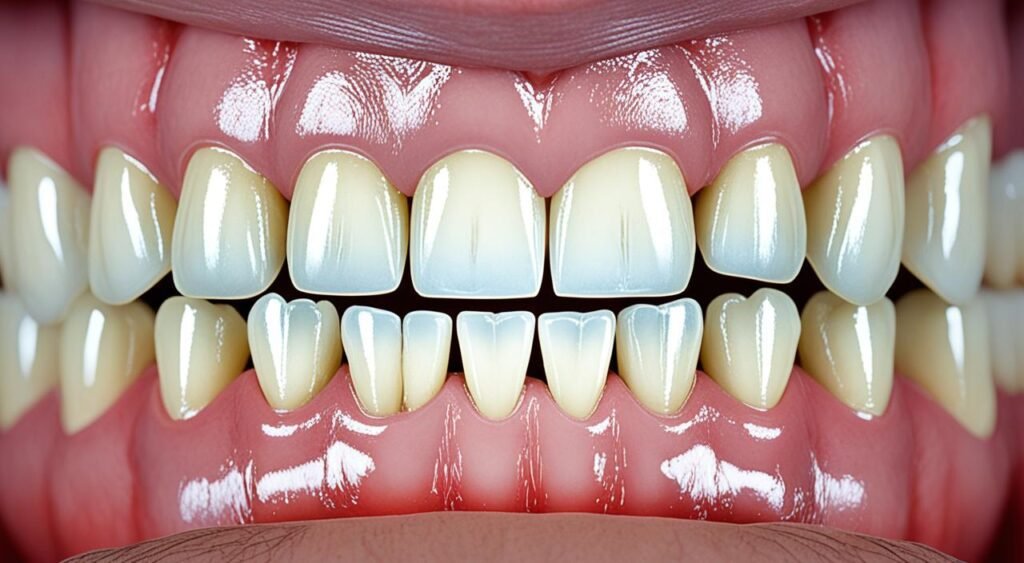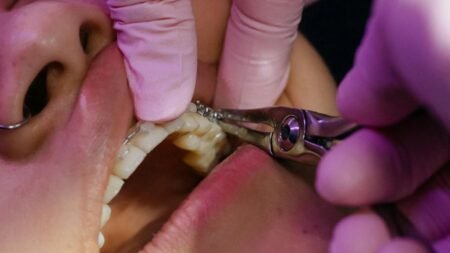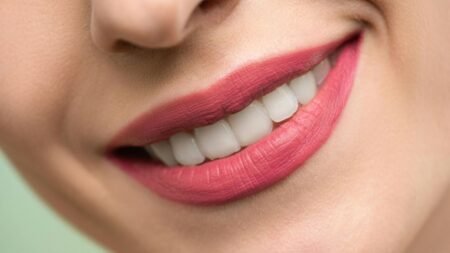Have you ever thought your teeth might be moving without you noticing? This change can happen slowly, affecting your oral health and alignment. It’s important to spot the signs your teeth are shifting early to keep your teeth in check. Many things, like aging and lifestyle choices, can cause teeth to shift.
Knowing these signs can help you deal with the issue before it gets worse. By acting early, you can prevent bigger problems later on.
Understanding Tooth Shifting
Tooth shifting is a common process that happens naturally over time. It’s influenced by age, dental health, and lifestyle habits. As teeth and gums age, they change, affecting the teeth’s structure. This can cause teeth to move unexpectedly.
Natural Movement Over Time
Natural tooth movement is a normal part of aging. Many people see their teeth shift as they get older. Even after braces, teeth can move due to aging, gum disease, or tooth loss.
How Teeth Are Structured
The structure of teeth allows for some movement because of the dynamic nature of dental tissues. Problems like gum disease, tooth decay, and teeth grinding can affect alignment. Understanding these factors helps us see why teeth might shift.
Significance of Monitoring Changes
It’s important to watch for changes in your mouth. Catching early signs of shifting can prevent bigger issues. Regular dental visits and good oral hygiene help keep your smile healthy. Watching for changes helps fix problems early, protecting your teeth.
Common Causes of Teeth Shifting
Learning about teeth shifting causes can help you keep your teeth healthy. Many things can change how your teeth line up over time. This includes aging, losing teeth, and certain dental issues. Your daily habits also affect your teeth’s condition.
Aging and Its Impact
As people get older, their teeth and mouth change. This can lead to teeth shifting because the jawbone and gums weaken. Regular dental visits are key to fighting these changes.
Effects of Tooth Loss
Losing a tooth can make other teeth move. About 120 million Americans have lost at least one tooth. This movement can affect how you bite and can lead to more misalignment. Using implants or bridges can help keep teeth in place.
Dental Conditions and Lifestyle Habits
- Periodontal disease can harm gums or bone, weakening teeth support.
- 10% of adults and 15% of kids grind their teeth, which puts extra pressure on them.
- Brushing and flossing daily are crucial to stop dental issues that can cause shifting.
- Wearing a mouthguard can lessen damage from teeth grinding, helping keep teeth aligned.
Signs Your Teeth Are Shifting
It’s important to know the signs your teeth are moving to get help early. You might feel discomfort or see changes that could affect your mouth’s health. Spotting these signs early helps you get the right help before things get worse.
Movement and Displacement
You might see your teeth moving or shifting. They could look like they’re not in line or leaning to one side. This can happen as you get older or because of changes in your body’s hormones. Also, not wearing a retainer after getting your braces off can cause your teeth to move back.

Changes in Your Bite
Changes in how you bite could mean your teeth are shifting. You might struggle to bite or chew food properly. Signs like teeth overlapping or less space between them mean you might need to see a dentist.
Gaps and Crowding
New gaps or spaces between your teeth could mean they’re moving. This might be because teeth are missing or you have another dental problem. On the other hand, crowded teeth could mean your jaw doesn’t have enough room. Watching for these changes is key to keeping your teeth healthy.
| Signs | Causes | Potential Issues |
|---|---|---|
| Movement of teeth | Aging, gum disease, pressure from jaw | Difficulty biting and chewing |
| Changes in bite | Teeth grinding, jaw misalignment | Oral discomfort |
| Gaps and crowding | Tooth extraction, lack of space | Increased difficulty in oral hygiene |
Teeth Misalignment Symptoms
Spotting teeth misalignment early is key for good oral health. If you’ve seen changes in your teeth or how you speak, it’s time to check your dental alignment. Teeth moving can cause both looks and function problems.
Crooked Teeth Warning Signs
Signs of crooked teeth show in different ways. These include:
- Visible misalignment of teeth
- Gaps or crowding in your smile
- Difficulties with chewing or biting
- Changes in dental midline
- Swelling or pain in gums
These signs happen when teeth move for reasons like muscle pressure, jaw growth, or habits like teeth grinding. Knowing these signs helps tackle the root of teeth misalignment.
Changes in Speech Patterns
Teeth moving can also change how you speak. Misaligned teeth make speaking and saying words hard, leading to:
- An increase in lisping sounds
- Challenges with certain word pronunciations
- Strain while speaking due to discomfort
These speech changes show how your teeth and tongue work together when you talk. Watching for these changes can help spot misalignment early and lead you to orthodontic help.
Complications of Untreated Shifting Teeth
It’s crucial to address shifting teeth to keep your mouth healthy. If not treated, these issues can really mess up your teeth and overall health.
Dental Misalignment Issues
Teeth that don’t line up right can cause a lot of problems. They can wear down unevenly, making you more likely to get cavities and gum disease. Cleaning your teeth becomes harder, which ups the risk of infections.
Impact on Oral Health
Chewing or speaking can become uncomfortable because of misaligned teeth. Shifting teeth might even lead to tooth breaks. The uneven pressure can cause damage during activities like grinding or clenching.
Risk of TMJ Disorders
Shifting teeth that go untreated can lead to TMJ disorders. This condition hurts the jaw joint, causing pain and limited jaw movement. If not fixed, it can turn into chronic pain, really affecting your life.
How to Fix Shifting Teeth
If you notice your teeth shifting, it’s important to act fast to keep your smile looking great. There are several ways to fix this problem, like orthodontic treatments and steps you can take to prevent it.
Orthodontic Treatments: Braces and Aligners
Braces are a common way to fix teeth that are not aligned properly. You can choose from traditional metal braces, ceramic braces, or clear aligners. Aligners are a good choice if you want something less noticeable. They make shifting teeth more comfortable and help move them into the right spots.
After getting orthodontic treatment, wearing retainers is key to keeping your teeth in place. This means wearing them for at least 12 hours a day for the first six months after treatment. Then, you can wear them at night to keep your teeth aligned.
Some people might need lingual retainers. These are attached to the back of your teeth and are a permanent way to keep your teeth in line.
The Importance of Retainers
Retainers are very important for keeping your teeth in their new position. Wearing them for at least 12 hours a day for the first six months after treatment is recommended. Even wearing them at night can help keep your teeth in place.
For some, lingual retainers are a good option. They are attached to the back of your teeth and provide a permanent solution to prevent shifting.
Lifestyle Changes to Prevent Shifting
Changing your lifestyle can help prevent teeth from shifting. Good oral hygiene, like brushing and flossing, is crucial for your dental health. Regular dentist visits can catch any problems early.
If you grind or clench your teeth at night, using a mouth guard can help. Avoiding smoking and eating a balanced diet also helps keep your teeth healthy.
Conclusion
Knowing when your teeth are shifting is key to keeping your mouth healthy and avoiding problems. Teeth move naturally over time, and aging or dental issues can also affect them. Issues like bruxism or gum disease can make teeth shift more, hurting your dental health.
Regular dental visits and using orthodontic retainers help keep your teeth in place. If you see changes in your bite or tooth position, see a dentist for advice. Understanding dental health helps you make smart choices about your care.
Good oral hygiene, like brushing and flossing, helps prevent teeth from shifting. By focusing on these habits, you can keep your smile healthy and boost your confidence for many years.
FAQ – Shifting Teeth
What are the common signs your teeth are shifting?
Signs include teeth moving or gaps between them. Teeth may also crowd together or change your bite, causing chewing pain.
What causes teeth to shift over time?
Teeth shifting can be due to aging, losing teeth, gum disease, or habits like teeth grinding. Using teeth as tools also plays a role.
How can I tell if my teeth are misaligned?
Look for signs like crooked teeth or trouble speaking clearly. Changes in your bite and uneven tooth wear are also clues. Seeing these signs means it’s time to see a dentist.
What treatments are available for shifting teeth?
For shifting teeth, braces or clear aligners can help straighten them. After, wearing retainers is key to keeping your teeth in place.
Are there risks associated with untreated shifting teeth?
Yes, untreated teeth can lead to serious dental issues. This includes more tooth decay, gum disease, and TMJ disorders. These can cause jaw pain and make it hard to function.
Can lifestyle changes help prevent teeth from shifting?
Definitely! Good oral habits like proper brushing, avoiding teeth grinding, and regular dental visits can help. These actions lower the chance of teeth shifting.








